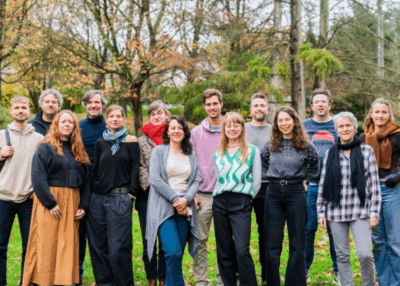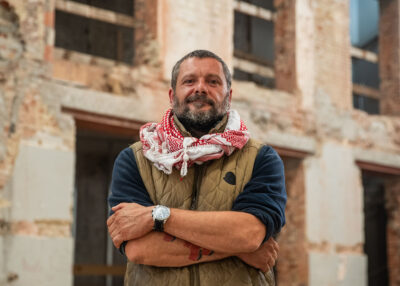
100 ideas to do business in Brussels European Quarter
Traders, residents, local authorities and academic experts answered hub.brussels’ questions. Mobility, the relationship between shopkeepers and the local population, green living, cultural life… everything has been discussed. Today we present you with 100 ideas to make the European quarter in Brussels a great place to live….. and to do business.
The suggestions are based on a market study conducted by hub.brussels and its partners. It contains a wealth of information for those who wish to launch or develop their business in Brussels while having a positive impact on the daily life in the European Quarter.
Video: people’s thoughts on the European district
A series of studies about the Brussels market
Between 2007 and 2011, Atrium.Brussels (Through its merger with Impulse.brussels and Brussels Invest & Export, the Regional Business Agency became hub.brussels, the Brussels Business Support Agency) created prospective district plans (PDPs) for 21 Brussels districts. Now, hub.brussels is developing a new, participative local business development methodology, the Think Innovate Develop (TID) programme.
The Think Innovate Develop (TID) programme
Through the TID programme the Agency intends to provide
- support and inspiration to creatives, prime contractors and project owners
- assist local authorities when making strategic decisions
- a series of “turnkey” project ideas, integrated into ther district and tailored to their target markets for the various stakeholders wishing to play a role in local business development
Focus on the European quarter
The European Quarter occupies an area belonging to three municipalities: the City of Brussels, Etterbeek and Ixelles. The district owes its name to the numerous buildings belonging to the European institutions and other international bodies, which moved there towards the end of the last century. Indeed, the European identity of the district is crystallised in these architectural symbols.
The European Parliament is located between Place du Luxembourg and Leopold Park, and European Commission Building “the Berlaymont” is close to Rue de la Loi et and the Schuman Roundabout.
Other iconic sites within the district include the Jean Monnet Crossing, situated alongside Rue Archimède, Place Jourdan and the more recently redeveloped Place Jean Rey. Businesses are spread out among these various hubs or centres within the district, which combine to create the local identity. Aside from “European Quarter”, other names for the area generally appear to be linked to Schuman. Other original names make reference to its symbolic identity: Brussels DC or EU District.
This publication also looks at other elements of the European Quarter that influence its identity and the way its is perceived from a retail development perspective.
In the TID study about the Brussels European Quarter you will find
- a context analysis
- maps
- key numbers
- typical profiles of merchants and residents
- a swot analysis
- testimonials
- …
100 ideas to inspire your company’s work in the European quarter
The 100 ideas compiled at the end of the TID study can inspire you. Perhaps your company already meets the expectations of the residents of the European Quarter. Perhaps you are looking for ways to start a business that would be both profitable and useful for Brussels. Anyway, you should like at least some of these ideas.
- Organise clown or puppet theatre shows.
- Offer subsidies so businesses can improve their lighting.
- Offer grants to renovate shopfronts.
- Install children’s play areas in Léopold Park.
- Repair the pavements.
- Redevelop Rue de la Loi.
- Promote pavement terraces.
- Install water fountains.
- Create a fitness trail.
- Review carparks at the entrance to the district.
- Set up shared vegetable gardens.
- Create a green wall.
- Build Pocket Parks (mini parks).
- Install kinetic pavements to generate electricity for the district.
- Promote electric buses.
- Promote travel by hoverboard and skateboard.
- Organise shuttle transport for local residents.
- Install bike parking outside businesses/buildings.
- Build more bike racks.
- Create more interesting cycle routes and footpaths.
- Install soundproofing panels in the street to reduce noise pollution.
- Make the district more green, add plants.
- Improve cooperation between public buses and sightseeing buses.
- Organise short rickshaw rides in the district.
- Improve Google listings of businesses.
- Hold acoustic concerts (listening and silence).
- Organise a day celebrating the districts.
- Organise activities for children out of school time.
- Use empty spaces to create places to relax after work.
- Organise “apéro” events and BBQs.
- Organise more events in Place Jean-Rey and Léopold Park.
- Organise Ecotrails.
- Place a totem in each sub-district.
- Create an overall identity that runs through all of the sub-districts.
- Place European key figures in each district.
- Install parasols on the terraces in the colours of the European flags.
- Install European flags throughout the district.
- Create a local “enterprise label” trademark.
- Develop mobile games for children (like Pokémon Go).
- Organise cultural activities in public spaces at the weekend.
- Reopen the theatre in the Résidence Palace.
- Construct a library box with books in all of the languages spoken in the European Union.
- Organise inter-district games.
- Install works of art representing Europe.
- Organise a theatre festival and events on the theme of Europe.
- Paint murals on the theme of Europe.
- Create a guide to local businesses.
- Advertise local businesses following the “adopt a shop keeper”)
- Create a label encouraging “young enterprise”, to support small business owners.
- Provide a structured system for word of mouth communication between customers and business owners to promote local business.
- Offer a smart, innovative business listings system to promote the district.
- Improve the welcome pack for new arrivals.
- Hear a particular sound as you pass a business- create sensory experiences associated with different shops.
- Introduce a loyalty system for bikes.
- Replace company cars with company bikes.
- Paint arrows on the ground stating the number of minutes on foot and by bike (like London).
- Limit the speed of cars.
- Install noise meters to measure decibels.
- Limit buses/the speed of cars.
- Improve the welcome pack for new arrivals.
- Distribute earplugs.
- Organise a silent happening, organise a very loud happening.
- Install noise prevention signage.
- Organise “meet the artist” sessions.
- Offer original commercial services.
- Diversify the range of services on offer.
- Open toy shops.
- Create an inter-district loyalty card.
- Use the ground floors of offices to create cultural pop-up stores.
- Change opening hours to meet the real needs of residents.
- Offer a larger range of prices.
- Invent a local currency.
- Install baffles in the street playing birdsong.
- Create a signposted walking route, allowing you to discover the district.
- Create urban itineraries: tour of the district inspired by comics or an exhibition, tour of the mills, history of the district, artists and sculptures in the district, “secret places”, app-based, rural routes, fitness.
- Organise tours of the district and offer guided visits to the businesses.
- Publicise cycling regulations.
- Open shops on Sunday.
- Control commercial rents.
- Limiter speeds in the area to 30km/h.
- Ban single person flats.
- Make housing more affordable.
- Create a ground plan of the district.
- Yoga classes.
- Choose district ambassadors to communicate between the various stakeholders.
- Maintain local retailers associations.
- Organise “retail business” coaching sessions.
- Hold more events in the shop.
- Organise a pub crawl.
- Place a focus on marketing.
- A more selective Property Management Service.
- Construct flexible green spaces.
- Tax empty premises.
- Devise a commercial cohousing system.
- The Property Management Services should have a more stringent selection process for businesses opening.
- Elect a public delegate.
- Train and inform business owners on sensory marketing.
- Choose a business owner to act as an ambassador of the local residents for communication purposes.
- Conduct “soft” monitoring of the district (impressions, ideas, wishes, needs), with citizens participating via an app or on the street.
- Create an identity that celebrates the contrasts of the European Quarter.
This action research project on the European Quarter, the Think Innovate Develop programme, is co-financed by the European Regional Development Fund and was established in collaboration with eQuama, European Quarter Area Management Association.
More news

Greenlab: Discover the new wave of circular industrial projects!
Posted on 09/01/2026
